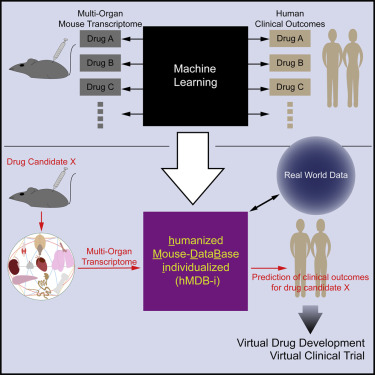iScience ( IF 5.8 ) Pub Date : 2020-01-09 , DOI: 10.1016/j.isci.2019.100791 Satoshi Kozawa 1 , Fumihiko Sagawa 1 , Satsuki Endo 1 , Glicia Maria De Almeida 2 , Yuto Mitsuishi 2 , Thomas N Sato 3

|
Approximately 90% of pre-clinically validated drugs fail in clinical trials owing to unanticipated clinical outcomes, costing over several hundred million US dollars per drug. Despite such critical importance, translating pre-clinical data to clinical outcomes remain a major challenge. Herein, we designed a modality-independent and unbiased approach to predict clinical outcomes of drugs. The approach exploits their multi-organ transcriptome patterns induced in mice and a unique mouse-transcriptome database “humanized” by machine learning algorithms and human clinical outcome datasets. The cross-validation with small-molecule, antibody, and peptide drugs shows effective and efficient identification of the previously known outcomes of 5,519 adverse events and 11,312 therapeutic indications. In addition, the approach is adaptable to deducing potential molecular mechanisms underlying these outcomes. Furthermore, the approach identifies previously unsuspected repositioning targets. These results, together with the fact that it requires no prior structural or mechanistic information of drugs, illustrate its versatile applications to drug development process.
中文翻译:

使用小鼠多器官转录组预测人类临床结果。
大约 90% 的临床前验证药物因临床结果出乎意料而在临床试验中失败,每种药物的成本超过数亿美元。尽管如此重要,将临床前数据转化为临床结果仍然是一个重大挑战。在此,我们设计了一种独立于模态且公正的方法来预测药物的临床结果。该方法利用了在小鼠中诱导的多器官转录组模式以及通过机器学习算法和人类临床结果数据集“人性化”的独特小鼠转录组数据库。与小分子、抗体和肽药物的交叉验证显示,对 5,519 种不良事件和 11,312 种治疗适应症的先前已知结果进行了有效和高效的鉴定。此外,该方法适用于推断这些结果背后的潜在分子机制。此外,该方法还可以识别以前未曾预料到的重新定位目标。这些结果以及它不需要药物的预先结构或机械信息的事实,说明了其在药物开发过程中的多功能应用。



























 京公网安备 11010802027423号
京公网安备 11010802027423号